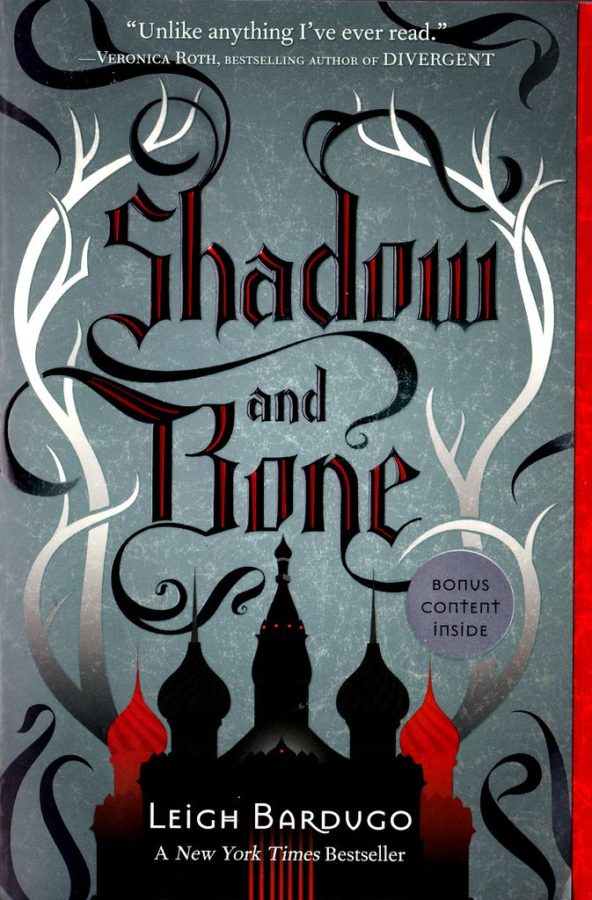Shadow and Bone is the YA fantasy we didn’t know we needed
June 10, 2021
The first in a trilogy, “Shadow and Bone” by Leigh Bardugo hits all the right YA fantasy spots. After a failed attempt to cross the dangerous Shadow Fold, Alina Starkov is revealed to be a Sun Summoner, the only person who can destroy the Fold and free her country. Aside from being extremely quotable, this novel is a new twist on an old formula, one that revives the YA fantasy genre.
Of course, the plot where the main character is the only one with the power to save the world is a tired trope, but under Leigh Bardugo’s direction, it becomes something a little different than what you are expecting. For starters, the world building is much different from what we as readers have come to expect from fantasy. Instead of medieval England or French inspiration, Alina’s home country of Ravka draws on a different, more modern source. The author herself has said, “Think Imperial Russia, not Medieval England, repeating rifles instead of broadswords.”
Bardugo has also come up with a unique magic system, which is honestly one of the biggest draws of this series. Instead of wizards or mages, the magic users in this universe are called Grisha, who have the ability to manipulate certain types of matter and call this the Small Science. Every Grish is born with this power, but they each have a different affinity for different elements. They are divided into three orders, each with a super cool name: Corporalki, Etherealki, and Materialki.
The Coroporalki (called the Order of the Living and the Dead) basically have control over the human body, and can do things like slow heartbeats or release chemicals in the brain. They are split into Heartrenders, which is self explanatory, and Healers.
The Etheralki (known as the Order of Summoners) have control over your typical elements. Squallers summon wind, Inferni control fire, and Tidemakers manipulate water. This is also the order that Alina belongs to, although she is a unique case as a Sun Summoner.
The last order is that of the Materialki (the Order of Fabrikators), which control metal and chemicals, things like that. They are split into Durasts and Alkemi, though the difference between them is only what kind of things they create.
This kind of unique magic system is something you do not come across very often, and the organization of their abilities also leads to plot points in the novel, such as the political struggle between Grisha and non-magic users and even within the Grisha as a whole.
This does not mean that Shadow and Bone does not fall prey to some of the overdone tropes; it includes a love triangle between Alina’s childhood best friend, Mal, and the mysterious Darkling, who happens to be the only Grisha to use shadow summoning and the leader of all the Grisha. Mal is your typical confident-boy-doesn’t-notice-her kind of character, and he honestly comes across as a little annoying. The Darkling is almost his opposite, a calm-cool-collected kind of male lead. This is also reinforced by his physical appearance (“quartz grey” eyes and dark hair, tall, muscular but not too muscular, you get it) and even his powers.
The Darkling ends up being the villain, because of course, but as a reader you still end up liking him way more than Mal. He is not your stereotypical brooding bad guy, instead taking on more charisma (like that of a cult leader, now that I think about it in respect to the ending), and an actual personality shaped by his backstory. Mal, in comparison, is so… flat. Like a cardboard cutout of the male lead you are supposed to root for. I mean, you know it is bad when most of your readers hope the villain will win.
Alina herself is not so bad. As the main character in a YA fantasy novel, she is a little flat, supposed to be somewhat of a blank slate for the reader to project on, and I can forgive that because she is actually not that bad. She has more personality than you would think, actual wit, and her character arc over the series actually makes you want to root for her instead of just wanting to replace her. She starts off as a very passive character, just kind of following along with a complaint here or there, and while that was annoying at first, as you read through the series you realize that it was necessary for her growth as she starts to take on more power and responsibility. For that reason, I would recommend reading all three books (which get progressively better).
It is at this point that I would like to talk about the Netflix adaptation of this series. Though the series would be fun to watch on its own, I absolutely recommend reading the series (both Shadow and Bone and the Six of Crows series, which is excellent) before watching the show. As someone who read the books, I can tell you that there is a lot of subtext and references that would make much more sense and just enhance your watching experience as a whole if you have read the books. This is not a review of the series—simply a recommendation. I would also like to mention that the plot of the Netflix series is pretty different from the plot of the books, so you will not have to worry about consuming the same plot twice.
If you are a fan of any kind of YA fantasy, this is a must read. Not only is it now a staple of the book community, but even if you do not normally enjoy that kind of read, this might still be interesting to you. I know it is still one of my top favorites.



